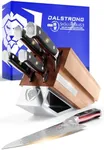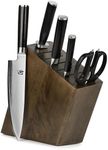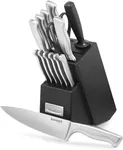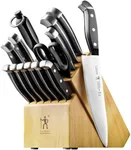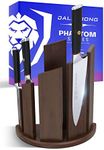Buying Guide for the Best Knife Blocks
Choosing the right knife block is essential for maintaining the quality and longevity of your knives, as well as ensuring safety and convenience in your kitchen. A knife block not only organizes your knives but also protects their blades from damage. When selecting a knife block, consider the types of knives you own, the material of the block, and the overall design that fits your kitchen style and needs.MaterialThe material of the knife block is important because it affects durability, aesthetics, and how well it protects your knives. Common materials include wood, bamboo, plastic, and stainless steel. Wooden and bamboo blocks are popular for their classic look and ability to protect knife blades, but they require regular cleaning to prevent bacteria buildup. Plastic blocks are easy to clean and often more affordable, while stainless steel blocks offer a modern look and are very durable. Choose a material that complements your kitchen decor and meets your maintenance preferences.
Size and CapacitySize and capacity refer to how many knives the block can hold and the overall dimensions of the block. This is important because you need a block that can accommodate all your knives without overcrowding. Knife blocks come in various sizes, from compact models that hold a few essential knives to larger ones that can store a full set. Consider the number of knives you currently own and any future additions. If you have limited counter space, a smaller block might be more suitable, while a larger block is ideal for extensive knife collections.
Slot DesignSlot design refers to the arrangement and size of the slots where the knives are inserted. This is crucial for ensuring that your knives fit securely and are easily accessible. Some blocks have universal slots that can accommodate various knife shapes and sizes, while others have specific slots for different types of knives, such as chef's knives, paring knives, and bread knives. If you have a diverse collection of knives, a block with universal slots might be more versatile. For specialized knife sets, a block with designated slots ensures each knife is stored properly.
Safety FeaturesSafety features in a knife block are important to prevent accidents and ensure that knives are stored securely. Look for blocks with non-slip bases to prevent tipping and sliding, and consider blocks with magnetic strips or other mechanisms that hold knives firmly in place. Some blocks also have child-proof designs to keep knives out of reach of young children. If safety is a priority in your household, choose a knife block with these features to minimize the risk of injury.
Ease of CleaningEase of cleaning is an important factor because knife blocks can accumulate dust, food particles, and bacteria over time. Blocks with removable inserts or open designs are easier to clean thoroughly. Wooden blocks may require more maintenance, such as regular oiling and disinfecting, while plastic and stainless steel blocks can be wiped down easily. Consider how much time and effort you are willing to invest in cleaning your knife block and choose one that aligns with your preferences.
Aesthetic AppealAesthetic appeal refers to how the knife block looks and how it fits into your kitchen decor. This is important because a knife block is often a visible part of your kitchen setup. Knife blocks come in various styles, from traditional wooden designs to sleek, modern stainless steel options. Choose a knife block that complements your kitchen's style and adds to the overall aesthetic. If you prefer a minimalist look, opt for a simple design, while a more decorative block can serve as a statement piece.



